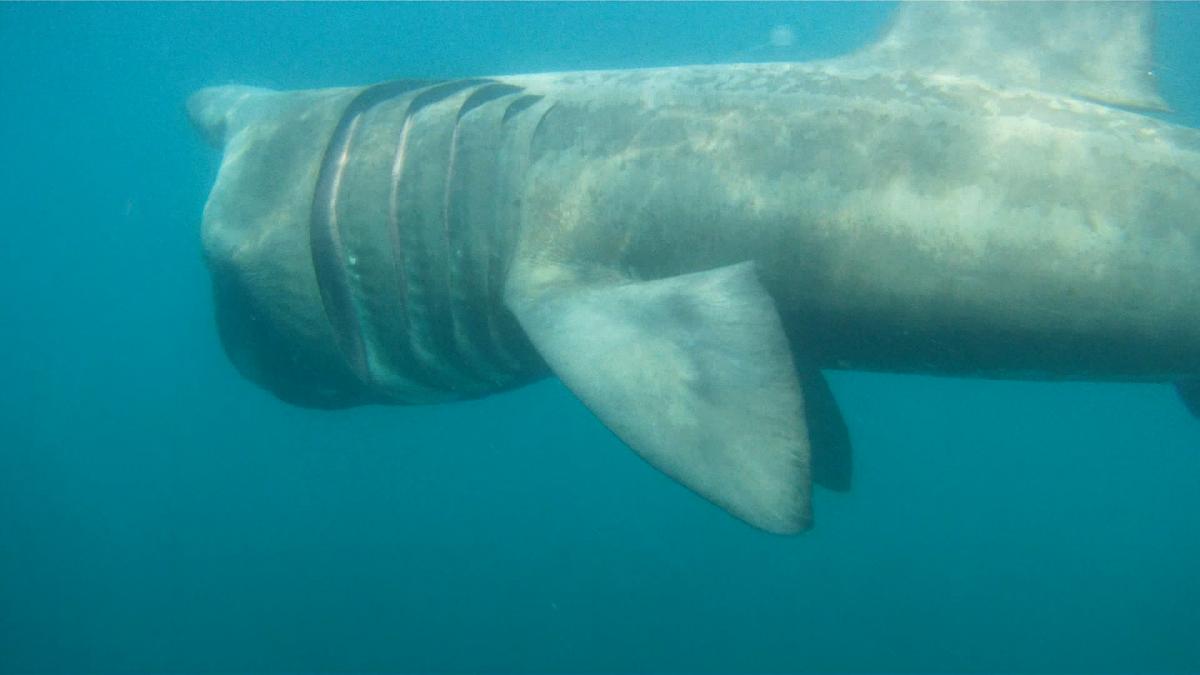The CMS Secretariat welcomes Colombia as the 27th country signing the Memorandum of Understanding on the Conservation of Migratory Sharks (Sharks MOU) with effect from 1 November 2013.
Cetorhinus maximus
The bask ing shark (Cetorhinus maximus) is a very large, filter feeding shark, second only to the whale shark in size. Adults grow to lengths of up to 12 meters and weights of up to 20 tons, though specimens of this size are now rare. Due to past overexploitation, specimens caught today usually fall between 6 to 10 meters in length as individuals are less likely to reach their maximum age. Similar to the whale shark, it possesses a greatly enlarged mouth and highly modified gill rakers, though its body is noticeably different with a fusiform shape, crescent-shaped caudal fin and pointed snout. The colouration is typically greyish-brown, black or dark-blue dorsally and a dull white or light-grey ventrally.
ing shark (Cetorhinus maximus) is a very large, filter feeding shark, second only to the whale shark in size. Adults grow to lengths of up to 12 meters and weights of up to 20 tons, though specimens of this size are now rare. Due to past overexploitation, specimens caught today usually fall between 6 to 10 meters in length as individuals are less likely to reach their maximum age. Similar to the whale shark, it possesses a greatly enlarged mouth and highly modified gill rakers, though its body is noticeably different with a fusiform shape, crescent-shaped caudal fin and pointed snout. The colouration is typically greyish-brown, black or dark-blue dorsally and a dull white or light-grey ventrally.
The term ‘basking’ refers to the animal’s habit of swimming and feeding slowly near the water’s surface. It is a filter feeder and employs a passive feeding mechanism which relies on the pressure of the passing water to push suspended prey through its gill rakers, distinct from the active suction filter technique of the whale shark. Prey items consist predominantly of zooplankton, small fish, fish eggs and invertebrates.
The basking shark is a cosmopolitan, pelagic and migratory species, with a circumglobal distribution across the temperate and boreal oceans. It favours cold water habitats of between 8°C and 14°C, and is believed to migrate and overwinter in deeper waters. Recent studies however, show that some individuals overwinter in warmer waters of lower latitudes. Animals of the coast of Cape Cod, Massachusetts migrate south to Brazil for the winter, crossing the equator and remaining at depths of between 200 meters and 1000 meters for the course of this journey.
Because of the shark’s sluggish and unaggressive nature, slow swimming speed and large size, the basking shark has been exploited for centuries for its liver oil, skin and meat. Its large and squalene-rich liver, accounting for up to 25% of its weight, has historically been used to supply oil of lighting and industrial use, its tough highly textured skin for leather and more recently, its fins, which are highly sought after for international trade to East Asia, for shark fin soup. Due to its slow maturity, long longevity and low reproduction rate, the basking shark is considered to be extremely vulnerable to overfishing, and population numbers have seen significant and rapid declines in the past few decades. As a result of this, the basking shark is legally protected in the US (regionally) and EU territorial waters, and trade in its products is restricted in many countries under CITES (Appendix II). It is currently listed in Appendix I and II of CMS, Annex I of the CMS Sharks MOU and Annex I of UNCLOS.
photo credit: Tobey Curtis, NOAA Fisheries Service
| CMS Instruments | CMS, Sharks (2010) |
|---|---|
| IUCN Status | Endangered |
| Date of entry in Appendix I | 2005 |
| Date of entry in Appendix II | 2005 |
| Countries | Albania, Algeria, Argentina, Australia, Belgium, Bosnia and Herzegovina, Brazil, Cabo Verde, Canada, Chile, China, Croatia, Cuba, Democratic People's Republic of Korea, Denmark, Ecuador, France, Germany, Greece, Haiti, Iceland, Ireland, Italy, Jamaica, Japan, Libya, Malta, Mexico, Monaco, Montenegro, Morocco, Namibia, Netherlands, New Zealand, Norway, Peru, Portugal, Republic of Korea, Russian Federation, Senegal, Slovenia, South Africa, Spain, Sweden, Tunisia, Türkiye, United Kingdom, United States of America, Uruguay |
|---|
| English | Basking Shark, (Traditionally Sunfish Or Sailfish, Hoe Mother) |
|---|---|
| French | Pélerin |
| Spanish | Peregrino |
| German | Riesenhai |
| Class | Chondrichthyes |
|---|---|
| Order | Lamniformes |
| Family | Cetorhinidae |
| Scientific name | Cetorhinus maximus |
| Author | (Gunnerus, 1765) |
| Standard reference | Eschmeyer, W.N. (1990). Catalogue of the Genera of Recent Fishes. California Academy of Sciences, San Francisco, California. |
| Additional notes | Cites listing: Appendix II |
|---|




